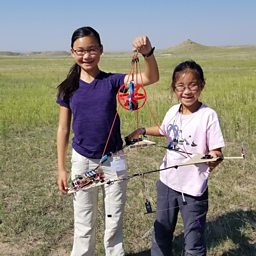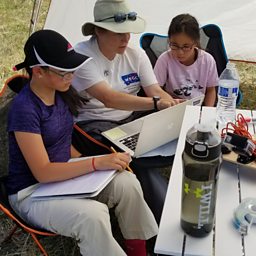The Loki Lego Launcher
We are Rebecca and Kimberly Yeung, two sisters who live in Seattle, and on August 21st, 2017, we launched a weather balloon project into the total solar eclipse.
by Rebecca and Kimberly YeungWeather balloon engineers
A weather balloon is an extremely large balloon that is filled with helium and has a payload attached to it that generally holds equipment used to predict the weather, hence the name.
Our launcher, or “spacecraft”, was called the Loki Lego Launcher. This was our third weather balloon launch, which started off as a small family project.
Our goals for this launch were:
- To capture footage of the moon’s shadow on the earth
- To capture and analyze data from our flight computer and solar panel (two of the instruments on our payload) as they pass through the solar eclipse.

The launcher!

We call our spacecraft the Loki Lego Launcher because on every launch, we send up a different Lego minifigure and a picture of our cat Loki. We chose this name because of the alliteration and because each word had a specific meaning to us.
For this launch, our Lego minifigure was Amelia Earhart, the first person to ever fly across the Atlantic Ocean by plane. We decided to choose her because she was a strong female pioneer and because she was famous for her aviation, we thought it was fitting for her to be on a spacecraft.
One of the other items on our payload was an action camera, which we used to film the Lego minifigure and Loki against the background of wherever the launcher was at the time. After writing a letter to the cmaera company, they kindly sent us an additional camera that we attached to the launcher to get another angle of the launcher’s view.
Another feature includes a SPOT GPS tracker, where we could get real-time data sent to an online website tracking where the launcher was. Last but not least, we had an Eagle Flight Computer, a computer board with a GPS tracker that can track all kinds of data.
We attached a solar panel that collected solar data during our second launch, and we were hoping to be able to see solar data during the eclipse.
The launch site!

For this launch, we worked with the Montana Space Grant Consortium (the MSGC) and they taught us some really cool things about weather balloons.
The MSGC is one of 52 other consortia in NASA's National Space Grant College and Fellowship Program, and they give opportunities to students who are interested in aeronautics or space.
After we got in touch with the MSGC, they graciously invited us to join them in Fort Laramie, Wyoming, a small town in seemingly the middle of nowhere, perfect conditions for a weather balloon launch.
The MSGC chose to launch in Wyoming instead of Montana because most of Wyoming was in the path of totality, the area where solar eclipse would be passing.
If you were anywhere else when the solar eclipse passed over the Earth you would only see a partial eclipse, if any at all. Since we were going to be launching in Wyoming, and it was over summer break, our family decided to also go on a family road trip.
We went to Yellowstone and Grand Teton National Park before going to Fort Laramie and saw tons of spectacular animals and landforms.
The eclipse!
This was such a unique experience!
As we mentioned before, we were launching this into the solar eclipse.
A solar eclipse occurs when the Sun, the Moon, and the Earth are all perfectly lined up, with the Moon in between the Sun and the Earth.
Even when the sun was partially covered, we still had to wear eclipse glasses, glasses with special lenses that let in very little light to look at the Sun.
The shadow of the Moon reflected onto the Earth’s surface and when the sun was completely covered by the Moon, we could take our eclipse glasses off and look at the amazing phenomenon. Because the Sun is blocked by the Moon, the bright daylight that we’re so used to turns very dark, and for about a minute it looked like it was the evening.
The team!
We had many incredible mentors for this project, one of whom is named Jen Fowler. Ms. Fowler was the assistant director for the Montana Space Grant Consortium, and she was leading the weather balloon launches in Wyoming.
Something that was really important about this launch was that we were working together with other balloon teams to make sure that everyone had a successful launch. This meant that if we needed someone to help us fill the balloon and keep it steady, we had more volunteers than we could use.
If we had a technical problem and needed help troubleshooting it, there were plenty of experts willing to share their knowledge or just help generate ideas.
One of the greatest things about having such a supportive team to work with was when we had finished a long hike to recover the spacecraft, a little bit disheartened and quite tired, we returned back to camp to people who genuinely cared about us and understood exactly how we felt about our results.
Having this encouragement and affirmation from teams who have way more experience than we do was truly amazing and something that we’ll always remember.




The launch!
We participated in an astrobiology experiment run by NASA, where we attached a sample of microbes, little bacteria to our launcher to see how the atmosphere affected it.
We were elated we had found it all in one piece!
The goal was to see how certain bacteria act in an atmosphere that is like Mars’, and the area our launcher was going to go had a similar atmosphere.
When we were actually launching, we needed multiple people to help us for two reasons:
- We had never worked with a balloon this large, it was 2000g and the previous launches were 360g and 600g.
- It was extremely windy, and we had to inflate our balloon inside so it didn’t move around. When we brought it outside, even with so many people, the wind still made it twist and turn in every direction.
The launch was really quick, with the people holding the balloon letting go first and us, at the other end holding the payload, letting go last. It was such an incredible moment when the balloon flew upwards until we couldn’t see anything but a tiny white dot.
Through our GPS tracker and the APRS data, we were able to track where the launcher was, and near the middle of its ascent, the launcher made its way over to Nebraska!
We were very surprised that the winds were that strong, and we thought we were going to have to drive into Nebraska to retrieve it. However, when the balloon popped, the wind seemed to change direction and actually headed back to Wyoming!
After we found out that the launcher had landed (we were getting GPS data in only one place), we drove to the area. We hiked through cow fields for hours until we got close to the launcher, but we still didn’t see it.
After wandering around the vicinity for a while, we finally spotted the bright orange of the parachute. We were elated that we had found it all in one piece!
However, after examining it more closely, we noticed that the camera facing Loki and Amelia was bent at an angle, and one of the wires on our solar panel had come loose. We were disheartened but decided to look at the positives, how everything else was still intact.
The debrief!
After every launch, one thing that we found that’s incredibly helpful is to debrief our mission and make a list of all the lessons that we learned from it. What this helps us do is to think about what went well and what didn’t so we can learn for future experiences and apply these lessons to other parts of our lives.
One of the biggest lessons that we learned from this launch was “follow your own advice”. That may sound obvious, but during the launch, there was a point where we weren’t following the same advice that we gave others.
We’d appeared on ABC’s Good Morning America earlier in the trip to talk about our project, and we’d given the advice to, “Don’t give up. Even if something goes wrong, which will happen, just keep on trying”. However, once we recovered our launcher and discovered that some things had gone wrong, we were really disappointed and felt defeated.
Once we later remembered our own words of perseverance, we had to laugh at ourselves and were quite cheerful after that.
Thanks for reading about our eclipse project! If you want to learn more about this or other projects,


One of the biggest lessons that we learned from this launch was...“follow your own advice”














